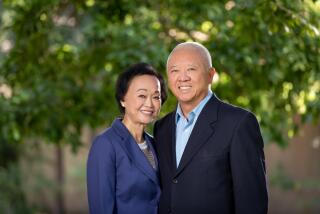In Honor of Life : Health: Bone marrow transplant recipients gather at City of Hope to mark their successful fight against illness. They also remember those who didn’t make it.
- Share via
Tears welled up in Alma Andrade’s eyes as she watched her favorite celebration take shape underneath a large party tent at the City of Hope National Medical Center in Duarte.
“This is what I wait for every year,” said the 21-year-old Los Angeles resident, her voice cracking as children and adults all around her laughed and hugged each other. “To me it’s more special than birthdays, Christmas or anything else. It’s another year that I live.”
Andrade is a bone marrow transplant recipient, one of about 200 who gathered at an emotional reunion last week to celebrate their recovery from leukemia, blood disorders and other life-threatening diseases. Many, including Andrade, came with the sibling who had donated the marrow to save their lives.
The Hughes family flew out from Mesa, Ariz., to mark 9-year-old John Hughes’ third anniversary since his transplant. While John romped around on the lawn with his brother and bone marrow donor, Matthew, now 11, their parents recalled the traumatic years that began when John was diagnosed as having acute lymphoblastic leukemia.
“It was a really upsetting time for the whole family,” said John’s mother, Petey. “I had to get a nanny to take care of the (other) kids. I’d come (to City of Hope) and stay for a week. Mike (her husband) was able to leave Fridays and stay during the weekend. Sometimes we’d meet each other in the airport and switch keys right there.”
At the reunion Friday, television cameras and reporters surrounded City of Hope’s second-longest transplant survivor, Marilyn Gaffney, who came with three of the four children she has adopted since her transplant 13 years ago. Because of the massive doses of chemotherapy and radiation she received in preparation for her transplant, Gaffney could not bear children.
These were the lucky ones, said Dr. Stephen Forman, director of City of Hope’s department of hematology and bone marrow transplantation. There is only a one-in-four chance siblings will have matching bone marrow types.
Forman asked for a moment of silence in memory of those who weren’t so fortunate.
“Remember the people not with us today,” Forman told the crowd of about 500 as they munched on sandwiches, rolled video cameras, and snapped photographs with doctors and nurses.
Forman recalled the first transplant survivor’s party 14 years ago, when a handful of nurses and doctors gathered in the patient’s room and celebrated with a birthday cake. In succeeding years, the hospital cafeteria served as the party room, and nurses would make spaghetti and hang a pinata, he said.
It is still largely a family affair, but that may change soon because of recent advances in matching unrelated donors and patients.
Until recently, finding an unrelated bone marrow donor--a one-in-20,000 chance--was virtually impossible. Now, there are computerized registries to match unrelated patients and donors across the nation and internationally.
“I hope next year we’ll have patients and donors here who are strangers,” Forman said.
Patients took turns at the microphone to talk about the diseases that almost took their lives. Some thanked their doctors and nurses. Others wept openly.
“You try to forget the bad part, and remember the good part,” one former patient said. “Thank God we’re all here.”






